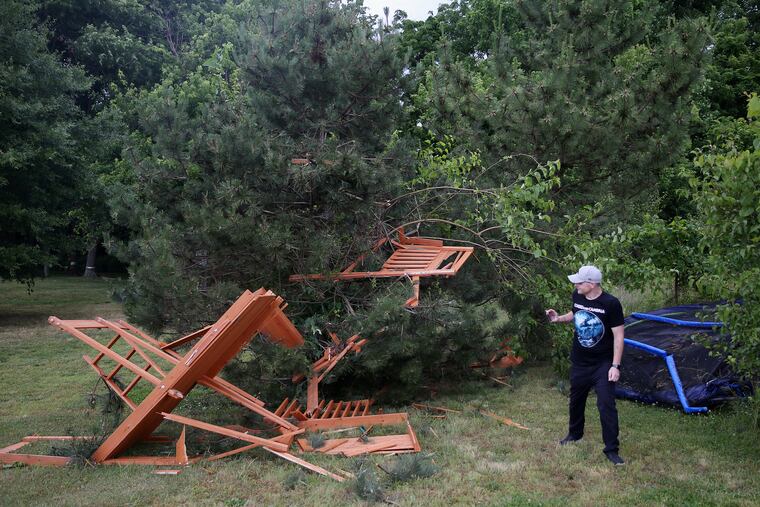Tornadoes touch down in South Jersey: ‘It just happened so fast’
The quick-moving storm knocked down trees and power lines and ripped siding and shingles from homes.

Two tornadoes touched down in South Jersey on Thursday night, recording winds whipping up to 100 mph, the National Weather Service, assessing the extent of damage, said Friday.
The quick-moving storms in Gloucester to Camden counties ripped siding and shingles from homes.
The first tornado was classified by the federal agency as an EF0 — the least-powerful category of tornado, with wind speeds from 65 to 85 mph — when it touched down around 8:15 p.m. in Harrison Township’s Mullica Hill section.
A second twister occurred in Deptford and Blackwood around 8:30 p.m., touching down intermittently for two miles. The weather service classified it as an EF1, with wind speeds from 90 to 100 mph.
Shortly after the storm passed through the area Thursday night, the weather service confirmed a tornado touched down in Mullica Hill based on a video showing “a clear funnel with some small debris being lofted.”
Chad Shafer, a meteorologist at the National Weather Service regional office in Mount Holly, said the team went to Salem, Gloucester, and Camden counties Friday and determined that damage in Salem County, near the city of Salem and Woodstown, was caused by straight-line winds of 60 to 80 mph.
The extent of damage was not fully known, but Harrison Township Police Lt. Ronald Cundey said the department did not receive any calls about the twister.
"Other than people posting their own videos, you know probably as much about it as we do,” Cundey said. “I’m kind of surprised myself.”
Jessica DiBacco said her phone went off about 8:15 p.m. with a tornado warning. In about five minutes, as her husband was upstairs watching the sky out of a window, the wind picked up in Mullica Hill.
“It just happened so fast,” she said. “Quick wind, it got really, really dark and the rain started coming down really bad.”
DiBacco said trees surrounding the family’s home swayed so violently she feared they would snap.
She said her husband, Lou, yelled to take their two young sons and dogs to the basement for protection while he remained upstairs, watching and filming through the window.
Lou DiBacco would end up recording the tornado as it hit Matthew Melucci and Alexandra Kenyon’s home, about a half-mile away.
The tornado blew the family’s new playset and trampoline over a clump of trees; the grill across the deck. The wind started to pull items out of their open garage before Melucci rushed to shut the door. Gusts tugged at the roof, leaving cracks in the walls. Fence panels around their backyard pool fell down. A nearby tree landed close to their front yard.
“The wind was just insane,” Melucci said. Fragments of what was once a playset for his 7- and 3-year-old sons were scattered in the grass.
The family huddled in the basement for about 20 minutes. Once the tornado seemed to have quieted, Melucci and Kenyon cautiously ventured outside.
“That’s when we saw everything gone,” Kenyon said.
In Gloucester Township, Blackwood Elementary School was closed Friday because it had no power and police there reported some streets were closed due to downed trees and power lines because of the second tornado.
The tornadoes were at least the fourth and fifth to touch down within 50 miles of Philadelphia in a month, and the second and third confirmed in New Jersey this year, following an EF-1 tornado that hit Stanhope in Sussex County on May 28, causing damage but no injuries. The state averages about two tornadoes a year, Shafer said.
Other recent tornadoes in the Philadelphia region include a May 19 twister at a Bucks County campground, a May 21 tornado in Berks County, and a May 22 twister on the Bucks-Lehigh border.
Bill Bunting, chief of the forecast operations branch at the storm center, in Norman, Okla., has said a stubborn pattern in the upper atmosphere has been particularly conducive to setting off the severe storms that spawn tornadoes this spring.
As of May 31, there had been 935 reported tornadoes in the United States so far in 2019, compared to an average of 1,125 for all of the last three years.
“The fact that it’s been persistent is unusual, but not unprecedented,” Bunting said.
Tornado numbers generally have increased, said Bunting, but that might be due to better detection, thanks to more sophisticated radar systems and increased reporting at a time when image-recording equipment is pervasive and continually improving.
As for the hand of worldwide warming, tornado specialists point out that twisters are idiosyncratic storms that get their ferocious spin from a complicated matrix of conditions.
“It’s not a cop-out,” said Bunting. “We just don’t know.”